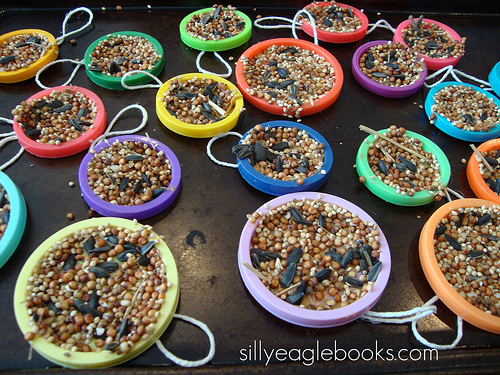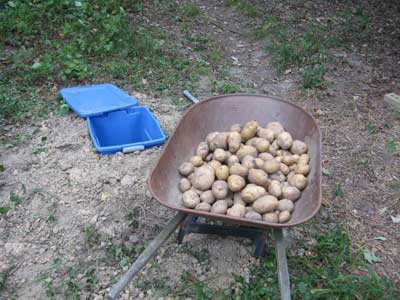Archive for December, 2010
Mix It Up
Making Your Own Mixes Can Save You Big



For years I purchased packaged mixes. You know the ones – chili, salad dressing, marinades and drinks. They may be quick and easy to use, but who needs all those chemicals so often used in processed foods coursing through your veins much less the increased cost of buying in small qualities. In just a few minutes on a slow evening you can create all of your family’s favorite mixes. Most ingredients will be in your stocked pantry and the ones you need to buy will cost a fraction per serving over the mixes you’re already buying.
Take for instance, Pumpkin Pie Spice. A container that weighs less than an ounce can cost between $3 and $4. But, if you have a well stocked pantry you probably already have all the ingredients you need to make your own – minus the preservatives that are added to commercially made mixes.
So take a few minutes and whip up your family’s favorites or most often used mixes. When stored in air tight containers they will last for months. Recycled pint-sized jars make the perfect container for most mixes, and have room for labels and recipes so they can be refilled later. Read the rest of the story »
Winter Solstice

Tomorrow, December 21st marks the winter solstice, the first day of winter, that moment in time when days begin to grow longer and the nights become shorter. This is a great marker on the calendar for me because it reminds me that spring is just a few months away. Our winter is still in full swing here on the farm though. The second set of storms has been pounding the area. Six inches of rain in just 2 days with no end in sight. It makes me wonder if I should be building an Ark rather than sitting at the kitchen table laying out the plans for my spring garden.
The girls (hens) are none to happy either. Last week they were prowling around the yard in search of worms and other bugs brought to the surface by the cool damp weather, but the last few days they’ve been hold up in the barn, not brave enough to venture out into the downpour. My plans to butcher our batch of meat birds have also succumbed to the weather and will be rescheduled for early January.
It’s still a magical time, despite the weather. One year is put to bed and put behind us while another stretches out before us, pushing above the surface like early spring peas.
![]() photo credit: brianfuller6385
photo credit: brianfuller6385
From our Farm to your Family…

SuburbanHomesteading.com Wishes you all a Happy, Healthy, Simple and “Homemade” Holiday Season.
![]() photo credit: José Ramón de Lothlórien
photo credit: José Ramón de Lothlórien
Souper Sunday Afternoon
The predicted storm did not materialize over the weekend, but the weather was still cold enough to enjoy a roaring fire all day long. It was a lazy Sunday afternoon with the wind billowing outside and grey clouds hanging low enough you felt like you could reach up a grab them. It was one of those days when you spent more time inside than out.
Weather like this cries out for food that’s warm and soothing. It calls out for a steaming, bubbling pot of soup; the kind that fills the house with aroma of herbs and spices; vegetables and meat.
When Brianne was younger I would send her to school with a thermos of piping hot soup almost every day of winter. It became the running joke in our house that “mom could make soup out of anything” and it wasn’t far off. Give me a leftover chicken carcass or a doggie bag of beef from a recent restaurant trip, along with a few veggies from the fridge and a small amount of pasta, rice or barley from the pantry and I could whip it into a steaming, hearty pot of soup, perfect for two.
We still eat a lot of soup during the winter months, transformed from a variety of leftovers or created from ingredients in our pantry. But, our creations are a bit more elaborate as our tastes have changed and our desires for more exotic creations have grown.
So, if old man winter gives you the cold shoulder fend him off with a simmering pot of soup. Paired with a salad and a warm loaf of homemade bread smothered in butter, you have the perfect cold day meal. Tonight’s soup…
Pasta Fagioli
2 pounds – ground beef
1 each – onion, chopped fine
3 each – carrots, chopped fine
4 each – stalks celery, chopped fine
28 oz – diced tomatoes, undrained (canned or homemade)
16 oz – red kidney beans, drained (if using dried, soak overnight)
16 oz – white kidney beans, drained (if using dried, soak overnight)
30 oz – beef broth (canned or homemade)
3 tsp – oregano
2 tsp – pepper
5 tsp – parsley
20 oz – spaghetti sauce (canned or homemade)
8 oz – small shell pasta
Brown beef in skillet; drain fat and add to crock pot. Add all remaining ingredients, except past to crock pot and cook on high for 5 to 6 hours. During last 30 minutes add pasta. Makes 12 servings. Top each bowl with parmesan cheese if desired.
Serve with warm focaccia bread and salad.
This is a great recipe for using up that chicken carcass.
It’s amazing how much meat is left on a carcass when it’s cooked down. Before starting, put carcass in large pot and cover with water. Bring to a boil and turn heat down to simmer for about an hour. Remove carcass and place on a cutting board to cool. Reserve 4 cups of broth, remaining can be ladled into freezer containers for later use. When carcass has cooled, pull off as much meat as you can. The recipe below is based on 2 cups of meat.
Greek Lemon Chicken Orzo Soup

4 cups – chicken stock, or 14 ounces of canned broth
2 cups – chicken, chopped into bite-sized pieces
3/4 cup – orzo pasta
2 eggs
Juice from 1 large lemon (or to your personal preference)
Coarse salt and ground pepper to taste
Italian parsley
In a stock pot, combine 1 cup of water and broth, bring to a rapid simmer, add orzo and cook according to package directions. Add chicken to pot. In medium bowl, whisk together eggs and lemon juice. Whisking constantly, slowly pour 1 cup hot broth into egg mixture, immediately whisk egg mixture into stock pot. Season soup with salt and pepper, garnish with parsley. Makes 2 large servings.
Serve with warm pita and hummus, and a salad of lettuce, red onion, tomato, Kalamata olives and Feta cheese with Greek dressing.
![]() photo credit: jessicafm and recipegirl
photo credit: jessicafm and recipegirl
![]() photo credit: randomcuriosity
photo credit: randomcuriosity
Beating the Winter Farm Blues

After the chaos of summer and the rush of fall harvest is over, we crave the slower days of winter; curled up in front of a fire with a good book. But once the tinsel and mistletoe is packed away and the groundhog reminds us we have a long way to go, cold days start to close in on us.
Don’t despair. With a dash of freshness you can shake off that cabin fever feeling. Try a few of our tips for beating the winter blues and savoring the slower weeks that lead us to the promise of spring:
1. Create some needed breathing space by decluttering, donating, freecycling or selling off old or unused stuff. You’ll feel ten pounds lighter instantly. Areas that could probably use a do-over: kitchen drawers, bathroom cabinets, clothing closets.
2. Winter is a great time to revive UFO’s (Un-Finished Objects). Projects that have been floating around for a while, things you started with good intentions and never had time to finish. To keep from getting overwhelmed, pick one project to complete each week.
3. Use farming’s off-season to re-inspire yourself and learn new skills. Read books, magazines or blogs about people who are living a simpler homesteading life. Research whether adding a new variety of animal or crop to your homestead is a good idea. Learn how other farmers have done it and gather resources that will help you decide.
4. Plan a Girl’s Night In. Invite friends and neighbors for a round of cards or other games. Or, have a cooking party to share favorite treats or discover new ones.
5. Treat yourself to a little pampering with a full body exfoliation before gardening season imbeds soil back under your nails. Try a homemade sugar scrub and relish the softness, a frugal alternative to pricey spa treatments.
Mix the following ingredients until they resemble a paste:
1 cup brown sugar
1/2 cup almond, safflower or sesame oil
1 T. honey
1 tsp. pure vanilla extract
While in the shower, massage the entire scrub in gentle circular motions from your shoulders to your feet, focusing on dry areas such as hands and heels. Rinse with warm water, using a little soap to wash off the oil. Dry off and moisturize.
6. Bring the outside in by hanging birdfeeders outside windows. The beautiful colors and zest for life will lift your spirits.
7. When outside weather permits take to the woods on a long walk. Look at your surroundings differently; hear what the world is supposed to sound like without lawnmowers or chainsaws. Savor the quiet and calm. The weather may be different, but you’ll still get a little shot of energy. Try a winter sport like cross-country skiing or snow-showing.
8. When it’s not too cold, open a window and let the smell of winter freshen your home.
9. Begin planning your garden and when the time is right, start some seeds in a sunny window
10. A few fresh ideas will go a long way in the dead of winter. Shake off the blahs with a trip to the library or local bookstore. Grab a hot drink and enjoy perusing periodicals and books on topics that interest you.
11. Use these quiet days to learn a new hobby like knitting, quilting, or baking. The uninterrupted time will give you loads of practice.
12. Keep up with exercise. It will improve your mood and help ward off depression.
13. Take care of yourself with a balanced diet of as many fresh items as possible. Try to stay away from overloading on carbs as they will turn into sugar and eventually pounds. And, don’t forget foods high in vitamin C to help ward off colds.
14. Stay connected with family and friends through the internet or by phone. It will make you feel less isolated.
15. Embrace the season. Even with the weather, winter has so much to offer – from new perspectives to the promise of a new year, finding your joy in the season can go a long way to lifting your spirits.
Challenge yourself to pick a few new ideas that interest you – new recipes, gardening techniques, building skills or travel destinations and bust out from the winter blahs.
A Newly Discovered Reason to Avoid Fast Food and Popcorn
As if unhealthy fast food wasn’t already a good reason to grow your own, here’s another one to consider – it’s linked to cancer, infertility, thyroid problems, and elevated cholesterol. But it’s not limited to fast food. Popcorn and other common items found in your kitchen are implicated, too.
Chemicals in food packaging are seeping into food and entering the human body and blood stream. This must be why some foods taste like plastic or chemicals. Yuk!
To read more click here articles.mercola.com
Finding Organic Seeds

Thanksgiving may be over and Christmas just around the corner, but like any avid gardener my mind is focused on spring – spring harvest of early peas and salad greens, spring turning of soil laden with organic matter and left to rest, spring planting of seeds started in the kitchen over a cold winter. Yep – spring is a busy time for we gardeners. But, the work of a garden starts long before our first chance to poke seeds deep into warm compost rich soil. It starts with a plan, a drawn out plotted map of vegetable placements, and segways to the best job of all in my opinion – ordering seeds. I love pouring over websites and catalogs almost as much as I love being down on my hands and knees digging in the dirt.
Seeds companies have come a long way over the last 20 years or so. With the rise in organic farming and home gardening seed companies have stepped up to meet the demand. One major advantage in this increase is that we can use our purchasing power to move agriculture in a more organic direction. Another benefit is that we are supporting companies that use non-toxic, sustainable methods to produce seeds.
Certified organic growers are required to use certified organic seed if it’s available. By choosing organic seeds we help ensure the continued supply of seeds that have not been genetically modified or treated with synthetic chemicals, which benefits not only home gardeners, but also organic farms as well. Read the rest of the story »
Suburban Root Cellar

Long before the first icebox was put into use or the first refrigerator was invented families used root cellars to keep their harvest fresh through the cold and bleak winter months. Cellars kept apples, carrots, turnips, potatoes and squash, even salt pork and smoked meats, milk, cream, butter and cheese were kept in the root cellar to stay cool and fresh, ready to sustain the family until spring crops could be harvested.
Root cellars are low-tech natural choices for keeping your harvest fresh for months without depending on ozone-depleting refrigeration, or electricity. Canned fruits and vegetables can also be stored at the optimum temperature in root cellars.
Unfortunately, most root cellars are large walk-in structures dug into the ground or the side of a hill, built with stone and beams and wooden roofs, piled high with dirt. Above ground cellars are covered with thick layers of sod to keep them cool inside. These are hardly conducive to a homestead on a suburban lot.
So, how can the suburban homesteader benefit from centuries of free refrigeration?
Using lidded plastic storage bins is one way (like the picture above). Storage bins come in several sizes measuring two feet to three or four feet in length and most are barely two feet deep, making them easier to reach the bottom than the more commonly used 55-gallon drum. They can be dug into the ground or into a small sloped area. Bins can even be placed in the ground at an angle half way with the excavated dirt used under the front of the bin to bury them up to their lids. Sloping the bins means that water will drain away better. These bins have a curled lip around the edge, allowing for small holes to be drilled all around for a bit of air circulation without letting in any water or mice.
To store root vegetables, first put down a layer of straw in the bottom of the bin, then a layer of vegetable, then more straw and another layer of vegetable, and so on until the bin is full. Ripe, unblemished fruit can be individually wrapped and placed in a padded cardboard box before placing into the bin. When each bin is full, autumn leaves or more straw can be piled on top a foot or so for added insulation. Normal winter conditions in different areas will determine how deep the bins need to be placed and how much they need to be covered. When it’s time to use your stores simply push aside the snow and leaves and lift the lid to get what you need. Be sure to check for softening or spoilage. If this occurs remove the affected fruits or vegetables and use quickly. Remember the old saying – “One bad apple can spoil the whole bushel”.
That’s all there is to it. What could be a simpler, more secure food supply? Even if the electricity goes off, your buried treasure will be safe, able to feed your family, which is more than you can say about gold.
APPROXIMATE STORAGE TIMES:
1 to 2 Weeks: Broccoli, Eggplant
2 to 4 Weeks: Cauliflower
3 to 5 Weeks: Brussel Sprouts
1 to 2 Months: Jerusalem Artichokes, Tomatoes, Chinese Cabbage, Parsnips
2 to 3 Months: Radishes, Rutabagas
3 to 4 Months: Cabbage, Squash
4 to 6 Months: Beets, Carrots, Potatoes, Turnips
5 to 6 Months: Pumpkins


Recent comments
Aenean nonummy hendrerit mauris. Phasellus porta.